Assessing the Underlying Drivers of Change over Two Decades of Land Use and Land Cover Dynamics along the Standard Gauge Railway Corridor, Kenya
Abstract
1. Introduction
2. Materials and Methods
2.1. Study Area and SGR Project Description
2.2. Methods
2.2.1. Land Use and Land Cover (LULC) Mapping
Data Source and Image Processing
Image Classification and Production of the LULC Maps
Accuracy Assessment
Land Use and Land Cover Change Analysis
2.2.2. Drivers for Land Use Land Cover Changes along the SGR Corridor
- (a)
- Biophysical Factors
- (b)
- Socio-Economic Factors
3. Results
3.1. Accuracy Assessment
3.2. Land Use and Land Cover for 2000, 2010 and 2019
3.3. Land Use and Land Cover Change between 2000 and 2019
3.4. Drivers of Land Use Land Cover Changes in the SGR Corridor
3.4.1. Biophysical Factors
The Land Use and Land Cover Changes across the AEZs between 2000 and 2019
Changes in LULC in the AEZs
3.4.2. The Socio-Economic Factors
4. Discussion
4.1. Changes by LULC Class
4.2. Underlying Biophysical and Socio-Economic Drivers
5. Conclusions
Author Contributions
Funding
Data Availability Statement
Acknowledgments
Conflicts of Interest
References
- Dewan, A.M.; Yamaguchi, Y. Land use and land cover change in Greater Dhaka, Bangladesh: Using remote sensing to promote sustainable urbanisation. Appl. Geogr. 2009, 29, 390–401. [Google Scholar] [CrossRef]
- Li, Y.; Zhu, X.; Sun, X.; Wang, F. Landscape effects of environmental impact on bay-area wetlands under rapid urban expansion and development policy: A case study of Lianyungang, China. Landsc. Urban Plan. 2010, 94, 218–227. [Google Scholar] [CrossRef]
- Laurance, W.F.; Sloan, S.; Weng, L.; Sayer, J.A. Estimating the environmental costs of Africa’s massive “development corridors”. Curr. Biol. 2015, 25, 3202–3208. [Google Scholar] [CrossRef] [PubMed]
- Alamgir, M.; Campbell, M.J.; Sloan, S.; Goosem, M.; Clements, G.R.; Mahmoud, M.I.; Laurance, W.F. Economic, socio-political and environmental risks of road development in the tropics. Curr. Biol. 2017, 27, R1130–R1140. [Google Scholar] [CrossRef]
- DCP Kenya. Development Corridors in Kenya—A Scoping Study; A Country Report of the Development Corridors Partnership (DCP); Institute for Climate Change and Adaptation (ICCA) the University of Nairobi and African Conservation Centre (ACC): Nairobi, Kenya, 2019; Available online: https://developmentcorridors.org/wp-content/uploads/2019/02/Development-Corridors-in-Kenya_Scoping-Report-2019.pdf (accessed on 22 March 2021).
- Nyumba, T.O.; Sang, C.C.; Olago, D.O.; Marchant, R.; Waruingi, L.; Githiora, Y.; Kago, F.; Mwangi, M.; Owira, G.; Barasa, R.; et al. Assessing the ecological impacts of transportation infrastructure development: A reconnaissance study of the Standard Gauge Railway in Kenya. PLoS ONE 2021, 16, e0246248. [Google Scholar] [CrossRef]
- Damarad, T. Habitat Fragmentation Due to Transportation Infrastructure: Findings of the COST Action 341; Office for Official Publications of the European Communities: Luxembourg, 2003; Available online: https://www.iene.info/content/uploads/2013/10/COST341_final_report.pdf (accessed on 2 February 2021).
- Jaeger, J.A.; Bertiller, R.; Schwick, C.; Müller, K.; Steinmeier, C.; Ewald, K.C.; Ghazoul, J. Implementing landscape fragmentation as an indicator in the Swiss Monitoring System of Sustainable Development (Monet). J. Environ. Manag. 2008, 88, 737–751. [Google Scholar] [CrossRef]
- Redwood, J. Managing the Environmental and Social Impacts of Major Road Investments in Frontier Regions: Lessons from the Inter-American Development Bank’s Experience; Inter-American Development Bank: Washington, DC, USA, 2012; Available online: https://publications.iadb.org/en/managing-environmental-and-social-impacts-major-road-investments-frontier-regions-lessons-inter (accessed on 13 December 2021).
- Perz, S.G.; Qiu, Y.; Xia, Y.; Southworth, J.; Sun, J.; Marsik, M.; Rocha, K.; Passos, V.; Rojas, D.; Alarcón, G.; et al. Trans-boundary infrastructure and land cover change: Highway paving and community-level deforestation in a tri-national frontier in the Amazon. Land Use Policy 2013, 34, 27–41. [Google Scholar] [CrossRef]
- Naboureh, A.; Bian, J.; Lei, G.; Li, A. A review of land use/land cover change mapping in the China-Central Asia-West Asia economic corridor countries. Big Earth Data 2021, 5, 237–257. [Google Scholar] [CrossRef]
- Hota, S.; Mishra, V.; Mourya, K.K.; Giri, K.; Kumar, D.; Jha, P.K.; Saikia, U.S.; Prasad, P.V.V.; Ray, S.K. Land Use, Landform, and Soil Management as Determinants of Soil Physicochemical Properties and Microbial Abundance of Lower Brahmaputra Valley, India. Sustainability 2022, 14, 2241. [Google Scholar] [CrossRef]
- Shukla, A.K.; Ojha CS, P.; Mijic, A.; Buytaert, W.; Pathak, S.; Garg, R.D.; Shukla, S. Population growth, land use and land cover transformations, and water quality nexus in the Upper Ganga River Basin. Hydrol. Earth Syst. Sci. 2018, 22, 4745–4770. [Google Scholar] [CrossRef]
- Hope, A.; Cox, J.; Development Corridors. Coffey International Development. 2015. Available online: https://assets.publishing.service.gov.uk/media/57a08995e5274a31e000016a/Topic_Guide_Development_Corridors.pdf (accessed on 8 January 2021).
- Hassan, Z.; Shabbir, R.; Ahmad, S.S.; Malik, A.H.; Aziz, N.; Butt, A.; Erum, S. Dynamics of land use and land cover change (LULCCC) using geospatial techniques: A case study of Islamabad Pakistan. SpringerPlus 2016, 5, 812. [Google Scholar] [CrossRef] [PubMed]
- Zander, P.; Kächele, H. Modelling multiple objectives of land use for sustainable development. Agric. Syst. 1999, 59, 311–325. [Google Scholar] [CrossRef]
- Thinh, N.X.; Arlt, G.; Heber, B.; Hennersdorf, J.; Lehmann, I. Evaluation of urban land-use structures with a view to sustainable development. Environ. Impact Assess. Rev. 2002, 22, 475–492. [Google Scholar] [CrossRef]
- Fayaz, A.; Ul Shafiq, M.; Singh, H.; Ahmed, P. Assessment of spatiotemporal changes in land use/land cover of North Kashmir Himalayas from 1992 to 2018. Model. Earth Syst. Environ. 2020, 6, 1189–1200. [Google Scholar] [CrossRef]
- Li, X.Y.; Ma, Y.J.; Xu, H.Y.; Wang, J.H.; Zhang, D.S. Impact of land use and land cover change on environmental degradation in Lake Qinghai watershed, northeast Qinghai—Tibet Plateau. Land Degrad. Dev. 2009, 20, 69–83. [Google Scholar] [CrossRef]
- Scanlon, B.R.; Jolly, I.; Sophocleous, M.; Zhang, L. Global impacts of conversions from natural to agricultural ecosystems on water resources: Quantity versus quality. Water Resour. Res. 2007, 43, W03437. [Google Scholar] [CrossRef]
- Putro, B.; Kjeldsen, T.R.; Hutchins, M.G.; Miller, J. An empirical investigation of climate and land-use effects on water quantity and quality in two urbanising catchments in the southern United Kingdom. Sci. Total Environ. 2016, 548, 164–172. [Google Scholar] [CrossRef]
- Khoi, D.N.; Nguyen, V.T.; Sam, T.T.; Nhi, P.T.T. Evaluation on Effects of Climate and Land-Use Changes on Streamflow and Water Quality in the La Buong River Basin, Southern Vietnam. Sustainability 2019, 11, 7221. [Google Scholar] [CrossRef]
- Williams, M.; Hopkinson, C.; Rastetter, E.; Vallino, J.; Claessens, L. Relationships of land use and stream solute concentrations in the Ipswich River basin, northeastern Massachusetts. Water Air Soil Pollut. 2005, 161, 55–74. [Google Scholar] [CrossRef]
- Schoonover, J.E.; Lockaby, B.G.; Pan, S. Changes in chemical and physical properties of stream water across an urban-rural gradient in western Georgia. Urban Ecosyst. 2005, 8, 107–124. [Google Scholar] [CrossRef]
- Tu, W.F.; Lin, J.D.; Wu, Y.L. An analysis of extinction coefficients of particles and water moisture in the stack after flue gas desulfurisation at a coal-fired power plant. J. Air Waste Manag. Assoc. 2011, 61, 815–825. [Google Scholar] [CrossRef] [PubMed]
- Li, L.L.; Zhang, Y.Z.; Tang, C.Y.; Zheng, L.; Meng, W.; Lu, S.Y.; Dun, Y. Modeling of Water Quality Response to Land-use Patterns in Taizi River Basin Based on Partial Least Squares. Huanjing Kexue 2017, 38, 1376–1383. [Google Scholar] [PubMed]
- Yamazaki, Y.; Muneoka, T.; Okazawa, H.; Kimura, M.; Tsuji, O. Evaluation of river water quality with multivariate analysis in clear stream watersheds in agricultural area. J. Water Environ. Technol. 2017, 15, 86–95. [Google Scholar] [CrossRef][Green Version]
- Chen, D.; Elhadj, A.; Xu, H.; Xu, X.; Qiao, Z. A Study on the Relationship between Land Use Change and Water Quality of the Mitidja Watershed in Algeria based on GIS and RS. Sustainability 2020, 12, 3510. [Google Scholar] [CrossRef]
- Msofe, N.K.; Sheng, L.; Lyimo, J. Land use change trends and their driving forces in the Kilombero Valley Floodplain, Southeastern Tanzania. Sustainability 2019, 11, 505. [Google Scholar] [CrossRef]
- Sloan, S.; Campbell, M.J.; Alamgir, M.; Engert, J.; Ishida, F.Y.; Senn, N.; Huther, J.; Laurance, W.F. Hidden challenges for conservation and development along the Trans-Papuan economic corridor. Environ. Sci. Policy 2019, 92, 98–106. [Google Scholar] [CrossRef]
- Soares-Filho, B.; Alencar, A.; Nepstad, D.; Cerqueira, G.; Vera Diaz, M.D.; Rivero, S.; Solórzano, L.; Voll, E. Simulating the response of land—cover changes to road paving and governance along a major Amazon highway: The Santarém–Cuiabá corridor. Glob. Chang. Biol. 2004, 10, 745–764. [Google Scholar] [CrossRef]
- Dong, S.; Li, Y.; Li, Y.; Li, S. Spatiotemporal patterns and drivers of land use and land cover change in the China-Mongolia-Russia economic corridor. Pol. J. Environ. Stud. 2021, 30, 2527–2541. [Google Scholar] [CrossRef]
- GOK. Kenya, Vision 2030. 2007. Available online: http://vision2030.go.ke/wp-content/uploads/2018/05/Vision-2030-Popular-Version.pdf (accessed on 28 June 2020).
- Government of Kenya. Sessional paper No. 10 of 2012 On Kenya Vision 2030. Government of Kenya—2012—Government Printers Nairobi. 2012. Available online: http://www.foresightfordevelopment.org/sobipro/54/1263-sessional-paper-no-10-of-2012-on-kenya-vision-2030#:~:text=Kenya%20Vision%202030%20is%20the,quality%20of%20life%20by%202030%E2%80%9D (accessed on 15 April 2021).
- Laurance, W.F.; Goosem, M.; Laurance, S.G. Impacts of roads and linear clearings on tropical forests. Trends Ecol. Evol. 2009, 24, 659–669. [Google Scholar] [CrossRef]
- Su, S.; Xiao, R.; Li, D. Impacts of transportation routes on landscape diversity: A comparison of different route types and their combined effects. Environ. Manag. 2014, 53, 636–647. [Google Scholar] [CrossRef]
- Wilkie, D.S.; Finn, J.T.; Finn, J. Remote Sensing Imagery for Natural Resources Monitoring: A Guide for First-Time Users; Columbia University Press: New York, NY, USA, 1996. [Google Scholar]
- Otuoma, J. The Effects of Wildlife-Livestock-Human Interactions on Habitat in the Meru Conservation Area, Kenya; LUCID Working Paper, No. 39; ILRI: Nairobi, Kenya, 2004; Available online: https://hdl.handle.net/10568/1905 (accessed on 6 March 2022).
- Ahmad, A.; Quegan, S. Analysis of maximum likelihood classification on multispectral data. Appl. Math. Sci. 2012, 6, 6425–6436. [Google Scholar]
- Anderson, J.R.; Hardy, E.E.; Roach, J.T.; Witmer, R.E. A Land Use and Land Cover Classification System for use with Remote Sensor Data; US Government Printing Office: Washington, DC, USA, 1976; Volume 964. [Google Scholar] [CrossRef]
- Anand, A. Unit-14 Accuracy Assessment; IGNOU: New Delhi, India, 2017; Available online: http://egyankosh.ac.in//handle/123456789/39544 (accessed on 5 May 2021).
- Hardin, P.J.; Shumway, J.M. Statistical significance and normalised confusion matrices. Photogramm. Eng. Remote Sens. 1997, 63, 735–739. [Google Scholar]
- Lewis, H.G.; Brown, M. A generalised confusion matrix for assessing area estimates from remotely sensed data. Int. J. Remote Sens. 2001, 22, 3223–3235. [Google Scholar] [CrossRef]
- Sarkar, A. Accuracy Assessment and Analysis of Land Use Land Cover Change Using Geoinformatics Technique in Raniganj Coalfield Area, India. Int. J. Environ. Sci. Nat. Resour. 2018, 11, 25–34. [Google Scholar]
- Carletta, J. Assessing agreement on classification tasks: The kappa statistic. Comput. Linguist. 1996, 22, 249–254. [Google Scholar]
- Viera, A.J.; Garrett, J.M. Understanding interobserver agreement: The kappa statistic. Fam Med. 2005, 37, 360–363. [Google Scholar]
- Foody, G.M.; Boyd, D.S.; Sanchez-Hernandez, C. Mapping a specific class with an ensemble of classifiers. Int. J. Remote Sens. 2007, 28, 1733–1746. [Google Scholar] [CrossRef]
- Lu, D.; Weng, Q. A survey of image classification methods and techniques for improving classification performance. Int. J. Remote Sens. 2007, 28, 823–870. [Google Scholar] [CrossRef]
- Martinis, S.; Kersten, J.; Twele, A. A fully automated TerraSAR-X based flood service. ISPRS J. Photogramm. Remote Sens. 2015, 104, 203–212. [Google Scholar] [CrossRef]
- Lu, A.; Kang, S.; Li, Z.; Theakstone, W.H. Altitude effects of climatic variation on Tibetan Plateau and its vicinities. J. Earth Sci. 2010, 21, 189–198. [Google Scholar] [CrossRef]
- FAO. Agro-Ecological Zoning; Guidelines: FAO Soils Bulletin 73, 78p; Soil Resources, Management and Conservation Service, FAO Land and Water Development Division; Food and Agriculture Organization of the United Nations: Rome, Italy, 1996; ISBN 92-5-103890-2. [Google Scholar]
- The World Bank Group. World Bank National Accounts Data, and OECD National Accounts Data Files. 2021. Available online: https://data.worldbank.org/indicator/NY.GDP.MKTP.CD?locations=KE (accessed on 5 May 2021).
- Satterthwaite, D.; McGranahan, G.; Tacoli, C. Urbanisation and its implications for food and farming. Philos. Trans. R. Soc. B Biol. Sci. 2010, 365, 2809–2820. [Google Scholar] [CrossRef] [PubMed]
- Destek, M.A.; Ozsoy, F.N. Relationships between economic growth, energy consumption, globalisation, urbanisation, and environmental degradation in Turkey. Int. J. Energy Stat. 2015, 3, 1550017. [Google Scholar] [CrossRef]
- Branca, G.; Lipper, L.; McCarthy, N.; Jolejole, M.C. Food security, climate change, and sustainable land man-agement. A review. Agron. Sustain. Dev. 2013, 33, 635–650. [Google Scholar] [CrossRef]
- Tandon, B.B.; Garg, A. Inclusivity and Sustainable Development. Indian J. Public Adm. 2009, 55, 882–891. [Google Scholar] [CrossRef]
- Qian, J.; Peng, Y.; Luo, C.; Wu, C.; Du, Q. Urban land expansion and sustainable land use policy in Shenzhen: A case study of China’s rapid urbanization. Sustainability 2015, 8, 16. [Google Scholar] [CrossRef]
- Musa, M.K.; Odera, P.A. Land Use Land Cover Changes and their Effects on Agricultural Land: A Case Study of Kiambu County Kenya. Kabarak J. Res. Innov. 2015, 3, 74–86. [Google Scholar]
- Wandaka, J.K.; Francis, K.M. Analysis of Impacts of Land Use Changes in Kitengela Conservation Area on Migratory Wildlife of Nairobi National Park, Kenya. Int. J. Appl. Sci. 2019, 2, 41. [Google Scholar] [CrossRef]
- Bai, Z.G.; Dent, D.L. Global Assessment of Land Degradation and Improvement: Pilot Study in Kenya. Report 2006/01, ISRIC-World Soil Information, Wageningen. 2006. Available online: https://www.isric.org/sites/default/files/isric_report_2006_01.pdf (accessed on 24 September 2021).
- Kiage, L.M.; Liu, K.B.; Walker, N.D.; Lam, N.; Huh, O.K. Recent land-cover/use change associated with land degradation in the Lake Baringo catchment, Kenya, East Africa: Evidence from Landsat TM and ETM+. Int. J. Remote Sens. 2007, 28, 4285–4309. [Google Scholar] [CrossRef]
- Kiage, L.M.; Liu, K.B. Palynological evidence of climate change and land degradation in the Lake Baringo area, Kenya, East Africa, since AD 1650. Palaeogeogr. Palaeoclimatol. Palaeoecol. 2009, 279, 60–72. [Google Scholar] [CrossRef]
- Mulinge, W.; Gicheru, P.; Murithi, F.; Maingi, P.; Kihiu, E.; Kirui, O.K.; Mirzabaev, A. Economics of land degradation and improvement in Kenya. In Economics of Land Degradation and Improvement—A Global Assessment for Sustainable Development; Springer: Cham, Switzerlands, 2016; pp. 471–498. [Google Scholar]
- Gichenje, H.; Godinho, S. A climate-smart approach to the implementation of land degradation neutrality within a water catchment area in Kenya. Climate 2019, 7, 136. [Google Scholar] [CrossRef]
- Olang, L.O.; Kundu, P.M. Land degradation of the Mau forest complex in Eastern Africa: A review for management and restoration planning. Environ. Monit. 2011, 528, 245–262. [Google Scholar]
- ROK. Taskforce Report on Forest Resources Management and Logging Activities in Kenya. 2018. Available online: http://www.environment.go.ke/wp-content/uploads/2018/08/Forest-Report.pdf (accessed on 26 September 2021).
- Juma, R.A. The Socio-Economic Impact of Deforestation and Eviction: A Study of the Ogiek Community of the Mau Forest, Kenya. Ph.D. Thesis, University of Nairobi, Nairobi, Kenya, 2012. [Google Scholar]
- Benjamin, F.R., Jr.; Barry, N. Haack. Deforestation in Kenya. J. Geogr. 1982, 81, 151. [Google Scholar] [CrossRef]
- DeFries, R.S.; Rudel, T.; Uriarte, M.; Hansen, M. Deforestation driven by urban population growth and agricultural trade in the twenty-first century. Nat. Geosci. 2010, 3, 178–181. [Google Scholar] [CrossRef]
- Erb, K.H.; Lauk, C.; Kastner, T.; Mayer, A.; Theurl, M.C.; Haberl, H. Exploring the biophysical option space for feeding the world without deforestation. Nat. Commun. 2016, 7, 11382. [Google Scholar] [CrossRef]
- Albertazzi, S.; Bini, V.; Lindon, A.; Trivellini, G. Relations of power driving tropical deforestation: A case study from the Mau Forest (Kenya). Belg. Rev. Belg. Géographie 2018, 2. [Google Scholar] [CrossRef]
- ROK. Constitution of Kenya. 2010. Available online: http://www.kenyalaw.org:8181/exist/kenyalex/actview.xql?actid=Const2010 (accessed on 3 November 2021).
- Rok. The Forest Conservation and Management Act, 2016. No. 34 of 2016. 2016. Available online: http://kenyalaw.org/kl/fileadmin/pdfdownloads/Acts/ForestConservationandManagementActNo34of2016.pdf (accessed on 2 March 2022).
- GOK. National Climate Change Response Strategy. Executive Brief. 2010. Available online: http://www.environment.go.ke/wp-content/documents/complete%20nccrs%20executive%20brief.pdf (accessed on 3 December 2021).
- Klopp, J.M.; Sang, J.K. Maps, power, and the destruction of the Mau Forest in Kenya. Georgetown J. Int. Aff. 2011, 12, 125–134. [Google Scholar]
- de Moraes MC, P.; de Mello, K.; Toppa, R.H. Protected areas and agricultural expansion: Biodiversity conservation versus economic growth in the Southeast of Brazil. J. Environ. Manag. 2017, 188, 73–84. [Google Scholar] [CrossRef]
- Kasraian, D.; Maat, K.; Stead, D.; van Wee, B. Long-term impacts of transport infrastructure networks on land-use change: An international review of empirical studies. Transp. Rev. 2016, 36, 772–792. [Google Scholar] [CrossRef]
- Gorte, R.W.; Sheikh, P.A. Deforestation and Climate Change. 2010. Available online: https://www.files.ethz.ch/isn/115286/140767.pdf (accessed on 25 July 2021).
- Longobardi, P.; Montenegro, A.; Beltrami, H.; Eby, M. Deforestation induced climate change: Effects of spatial scale. PLoS ONE 2016, 11, e0153357. [Google Scholar] [CrossRef]
- Fitawok, M.B.; Derudder, B.; Minale, A.S.; Van Passel, S.; Adgo, E.; Nyssen, J. Modeling the impact of urbanization on land-use change in Bahir Dar City, Ethiopia: An integrated cellular Automata–Markov Chain Approach. Land 2020, 9, 115. [Google Scholar] [CrossRef]
- Güneralp, B.; Lwasa, S.; Masundire, H.; Parnell, S.; Seto, K.C. Urbanisation in Africa: Challenges and opportunities for conservation. Environ. Res. Lett. 2017, 13, 015002. [Google Scholar] [CrossRef]
- Mundia, C.N.; Aniya, M. Analysis of land use/cover changes and urban expansion of Nairobi city using remote sensing and GIS. Int. J. Remote Sens. 2005, 26, 2831–2849. [Google Scholar] [CrossRef]
- Rok. National Report on Settlements and the New Urban Agenda towards Habitat III. 2016. Available online: http://habitat3.org/wp-content/uploads/Kenya-National-Report.pdf (accessed on 12 August 2020).
- ROK. Kenya Population Situation Analysis. Kenyan Government, Nairobi, 2013. Available online: https://www.unfpa.org/sites/default/files/admin-resource/FINALPSAREPORT_0.pdf (accessed on 23 June 2020).
- KNBS. Kenya Population and Housing Census. 2019. Available online: https://www.knbs.or.ke/ (accessed on 23 June 2020).
- Auya, S.; Oino, P. The role of constituency development fund in rural development: Experiences from North Mugirango Constituency, Kenya. Int. J. Sci. Res. 2013, 2, 306–312. [Google Scholar]
- Njuguna, C. Devolution and Its Effect on the Community: A Cross Sectional Study of Githunguri Constituency in Kiambu County. Ph.D. Thesis, University of Nairobi, Nairobi, Kenya, 2016. [Google Scholar]
- Ntara, C. Devolution and expected impact in Kenya. Int. J. Prof. Pract. 2013, 4, 7–14. [Google Scholar]
- Kithiia, S.M. An assessment of water quality changes within the Athi and Nairobi river basins during the last decade. IAHS Publ. 2007, 314, 205. [Google Scholar]
- Deng, X.; Huang, J.; Rozelle, S.; Uchida, E. Economic growth and the expansion of urban land in China. Urban Stud. 2010, 47, 813–843. [Google Scholar] [CrossRef]
- Liu, Y.; Chen, Y. Impact of population growth and land-use change on water resources and ecosystems of the arid Tarim River Basin in Western China. Int. J. Sustain. Dev. World Ecol. 2006, 13, 295–305. [Google Scholar] [CrossRef]
- Ray, S.; Ray, I.A. Impact of population growth on environmental degradation: Case of India. J. Econ. Sustain. Dev. 2011, 2, 72–77. [Google Scholar]
- Thuo, A.D.M. Impacts of urbanisation on land use planning, livelihood and environment in the Nairobi rural-urban fringe, Kenya. Int. J. Sci. Technol. Res. 2013, 2, 70–79. [Google Scholar]
- Nwokoro, C., II; Dekolo, S.O. Land use change and environmental sustainability: The case of Lagos Metropolis. Sustain. City VII Urban Regen. Sustain. 2012, 1, 157–167. [Google Scholar]
- Jiang, L.; Deng, X.; Seto, K. CThe impact of urban expansion on agricultural land use intensity in China. Land Use Policy 2013, 35, 33–39. [Google Scholar] [CrossRef]
- Coxhead, I.; Shively, G.; Shuai, X. Development policies, resource constraints, and agricultural expansion on the Philippine land frontier. Environ. Dev. Econ. 2002, 7, 341–363. [Google Scholar] [CrossRef]
- United Nations Environment Programme. Progress on Freshwater Ecosystems: Tracking SDG 6 Series—Global Indicator 6.6.1 Updates and Acceleration Needs. 2021. Available online: https://wedocs.unep.org/bitstream/handle/20.500.11822/36691/PFE6.6.1.pdf?sequence=3&isAllowed=y (accessed on 6 November 2021).
- Kiage, L.M.; Douglas, P. Linkages between land cover change, lake shrinkage, and sublacustrine influence determined from remote sensing of select Rift Valley Lakes in Kenya. Sci. Total Environ. 2020, 709, 136022. [Google Scholar] [CrossRef]
- Olago, D.O.; Raini, J.; Omuombo, C.; Ogonda, G.; Muli, J.; Okello, C.; Ong’ang’a, O. Lentic-Lotic Water System Response to Anthropogenic and Climatic Factors in Kenya and Their Sustainable Management. In Climate Change and Water Resources in Africa; Springer: Cham, Switzerland, 2021; pp. 193–218. [Google Scholar]
- Sean, A. Scientists are Worried about the Impact of Kenya’s Rift Valley Lakes Flooding. 2020. Available online: https://qz.com/africa/1918674/scientists-worried-by-flooding-in-kenya-rift-valley-lakes/ (accessed on 12 February 2021).
- Abuje, S.J.; Otoki, B.M.; Njuguna, B.M.; Munala, G. The Vulnerability of Nairobi to the Effects of Climate Change between 1984 and 2016. Landsc. Archit. Reg. Plan. 2020, 5, 38. [Google Scholar]
- Mohamed, M.A. Mitigating the Effects of Intensive Agriculture on Wetlands: The Case of Saiwa Wetlands, Kenya. 2002. Available online: https://aquadocs.org/handle/1834/7384 (accessed on 3 March 2022).
- Rongoei, P.J.K.; Kipkemboi, J.; Okeyo-Owuor, J.B.; Van Dam, A.A. Ecosystem services and drivers of change in Nyando floodplain wetland, Kenya. Afr. J. Environ. Sci. Technol. 2013, 7, 274–291. [Google Scholar]
- Kibet, R.; Olatubara, C.O.; Ikporukpo, C.O.; Jebiwott, A. Land Use Land Cover Changes and Encroachment Issues in Kapkatet Wetland, Kenya. Open J. Ecol. 2021, 11, 493–506. [Google Scholar] [CrossRef]
- Macharia, J.M.; Thenya, T.; Ndiritu, G.G. Management of highland wetlands in central Kenya: The importance of community education, awareness and eco-tourism in biodiversity conservation. Biodiversity 2010, 11, 85–90. [Google Scholar] [CrossRef]
- Ramsar Convention on Wetlands. Ramsar Fact Sheet 3 Wetlands: A Global Disappearing Act. 2021. Available online: https://www.ramsar.org/sites/default/files/documents/library/factsheet3_global_disappearing_act_0.pdf (accessed on 6 November 2021).
- Staudt, A.; Leidner, A.K.; Howard, J.; Brauman, K.A.; Dukes, J.S.; Hansen, L.J.; Paukert, C.; Sabo, J.; Solórzano, L.A. The added complications of climate change: Understanding and managing biodiversity and ecosystems. Front. Ecol. Environ. 2013, 11, 494–501. [Google Scholar] [CrossRef]
- Grimm, N.B.; Chapin, F.S., III; Bierwagen, B.; Gonzalez, P.; Groffman, P.M.; Luo, Y.; Melton, F.; Nadelhoffer, K.; Pairis, A.; Raymond, P.A.; et al. The impacts of climate change on ecosystem structure and function. Front. Ecol. Environ. 2013, 11, 474–482. [Google Scholar] [CrossRef]
- Kröpelin, S.T.; Verschuren, D.; Lézine, A.M.; Eggermont, H.; Cocquyt, C.; Francus, P.; Cazet, J.P.; Fagot, M.; Rumes, B.; Russell, J.M.; et al. Climate-driven ecosystem succession in the Sahara: The past 6000 years. Science 2008, 320, 765–768. [Google Scholar] [CrossRef]
- McMahon, S.M.; Parker, G.G.; Miller, D.R. Evidence for a recent increase in forest growth. Proc. Natl. Acad. Sci. USA 2010, 107, 3611–3615. [Google Scholar] [CrossRef] [PubMed]
- Handavu, F.; Chirwa, P.W.; Syampungani, S. Socio-economic factors influencing land-use and land-cover changes in the miombo woodlands of the Copperbelt province in Zambia. For. Policy Economics 2019, 100, 75–94. [Google Scholar] [CrossRef]
- Chege, J.; Ngui, D.; Kimuyu, P. Scoping Paper on Kenyan Manufacturing (No. 2014/136). WIDER Working Paper. 2014. Available online: https://www.wider.unu.edu/sites/default/files/wp2014-136.pdf (accessed on 12 August 2020).
- De Luca, G.D. Roads, Development and Deforestation: A Review. Development Research Group Paper. 2017. Available online: https://forestindustries.eu/sites/default/files/userfiles/1file/roads2008.pdf (accessed on 12 August 2020).
- Tole, L. Sources of deforestation in tropical developing countries. Environ. Manag. 1998, 22, 19–33. [Google Scholar] [CrossRef]
- Baehr, C.; BenYishay, A.; Parks, B. Linking Local Infrastructure Development and Deforestation: Evidence from Satellite and Administrative Data. J. Assoc. Environ. Resour. Econ. 2021, 8, 375–409. [Google Scholar] [CrossRef]
- RoK. Sessional Paper No. 3 of 2012 on Population Policy for National Development. 2013. Available online: https://www.ncpd.go.ke/wp-content/uploads/2016/11/Population-Policy-for-National-Development-Final-July-2013.pdf (accessed on 12 August 2020).
- Hu, Z.; Lo, C.P. Modeling urban growth in Atlanta using logistic regression. Comput. Environ.t Urban Syst. 2007, 31, 667–688. [Google Scholar] [CrossRef]
- Liu, D.; Clarke, K.C.; Chen, N. Integrating spatial nonstationarity into SLEUTH for urban growth modeling: A case study in the Wuhan metropolitan area. Comput. Environ. Urban Syst. 2020, 84, 101545. [Google Scholar] [CrossRef]
- Smyth, A.J.; Dumanski, J.; Spendjian, G.; Swift, M.J.; Thornton, P.K. FESLM: An International Framework for Evaluating Sustainable Land Management; FAO: Rome, Italy, 1993; Volume 73. [Google Scholar]
- Nejadhashemi, A.P.; Shen, C.; Wardynski, B.J.; Mantha, P.S. Evaluating the impacts of land use changes on hydrologic responses in the agricultural regions of Michigan and Wisconsin. In 2010 Pittsburgh, Pennsylvania, June 20–June 23, 2010; American Society of Agricultural and Biological Engineers: St. Joseph, MI, USA, 2010; p. 1. [Google Scholar]
- Gashaw, T.; Tulu, T.; Argaw, M.; Worqlul, A.W. Modelling the hydrological impacts of land use/land cover changes in the Andassa watershed, Blue Nile Basin, Ethiopia. Sci. Total Environ. 2018, 619, 1394–1408. [Google Scholar] [CrossRef]
- Bunning, S.; De Pauw, E. Land Resource Planning for Sustainable Land Management. Current and Emerging Needs in Land Resource Planning for Food Security, Sustainable Livelihoods, Integrated Landscape Management and Restoration. Land and Water Division Working Paper (FAO) Eng No. 14. 2017. Available online: https://www.fao.org/3/i5937e/i5937e.pdf (accessed on 7 January 2022).
- FAO. Sustainable Land Management. 2022. Available online: https://www.fao.org/land-water/land/sustainable-land-management/slm-practices/en/ (accessed on 7 January 2022).
- Santato, S.; Bender, S.; Schaller, M. The European Floods Directive and Opportunities offered by Land Use Planning; CSC Report 12; Climate Service Center: Berlin, Germany, 2013; Available online: https://www.researchgate.net/publication/273274352_The_European_Floods_Directive_and_Opportunities_offered_by_Land_Use_Planning (accessed on 6 March 2022).

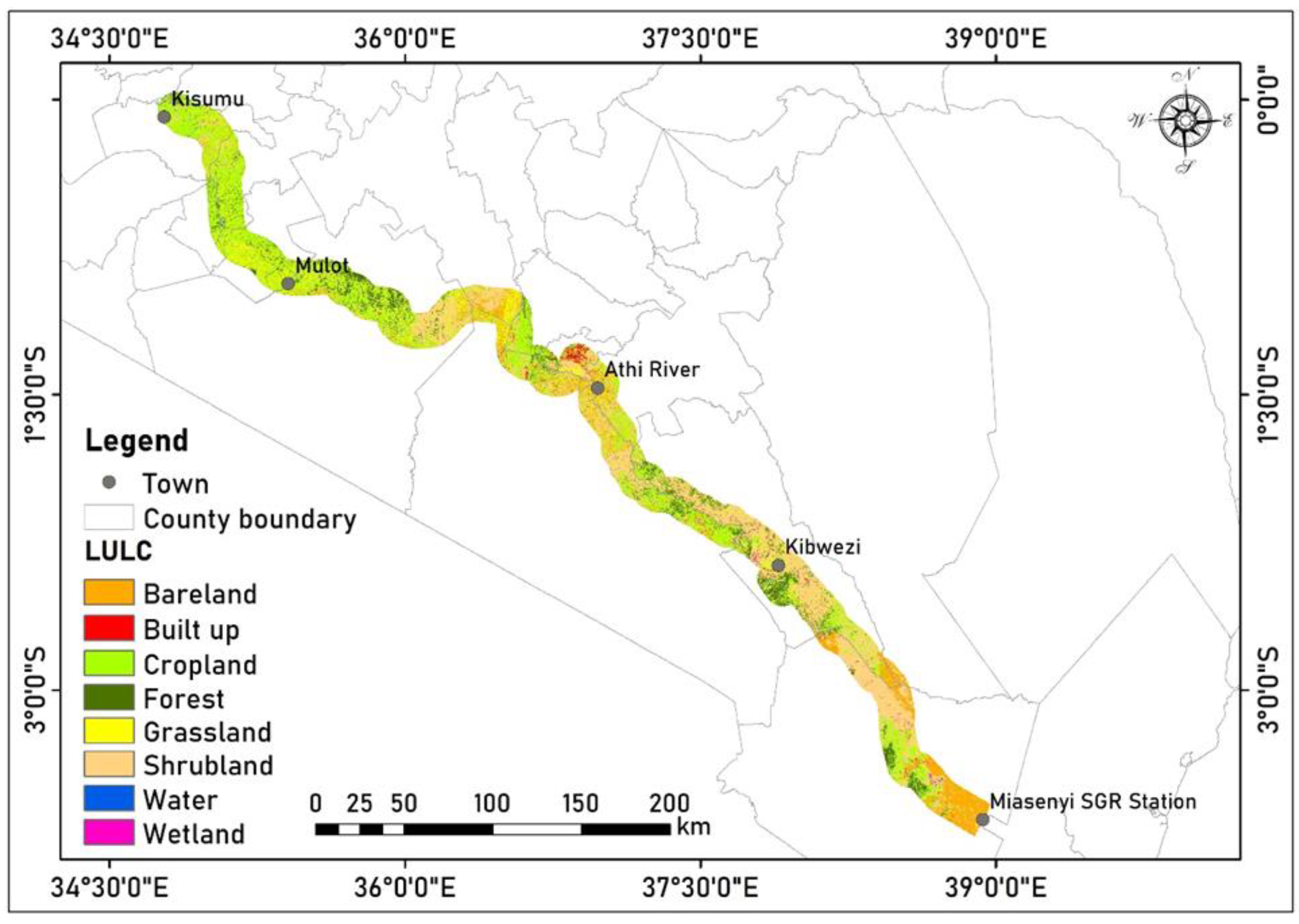
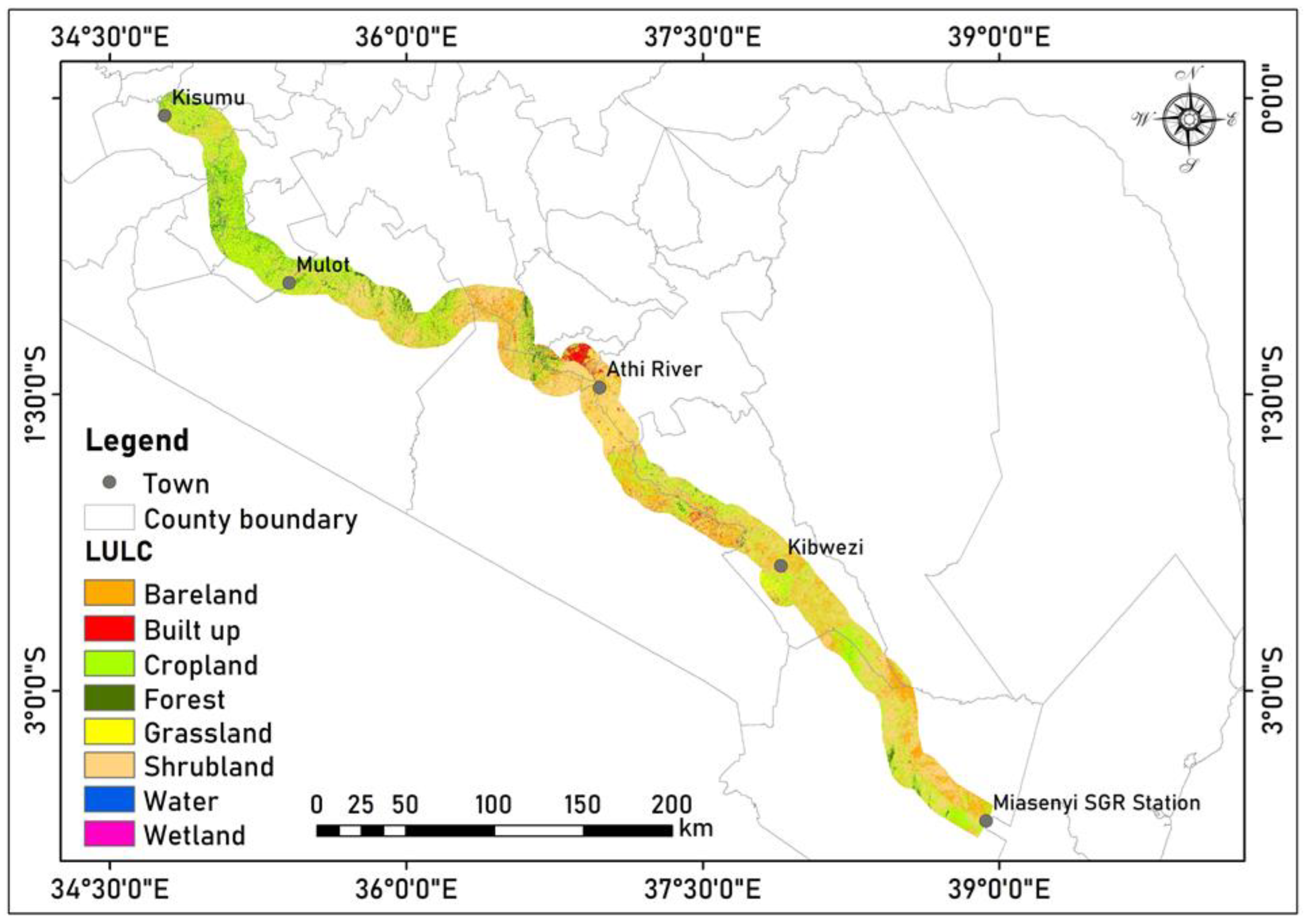
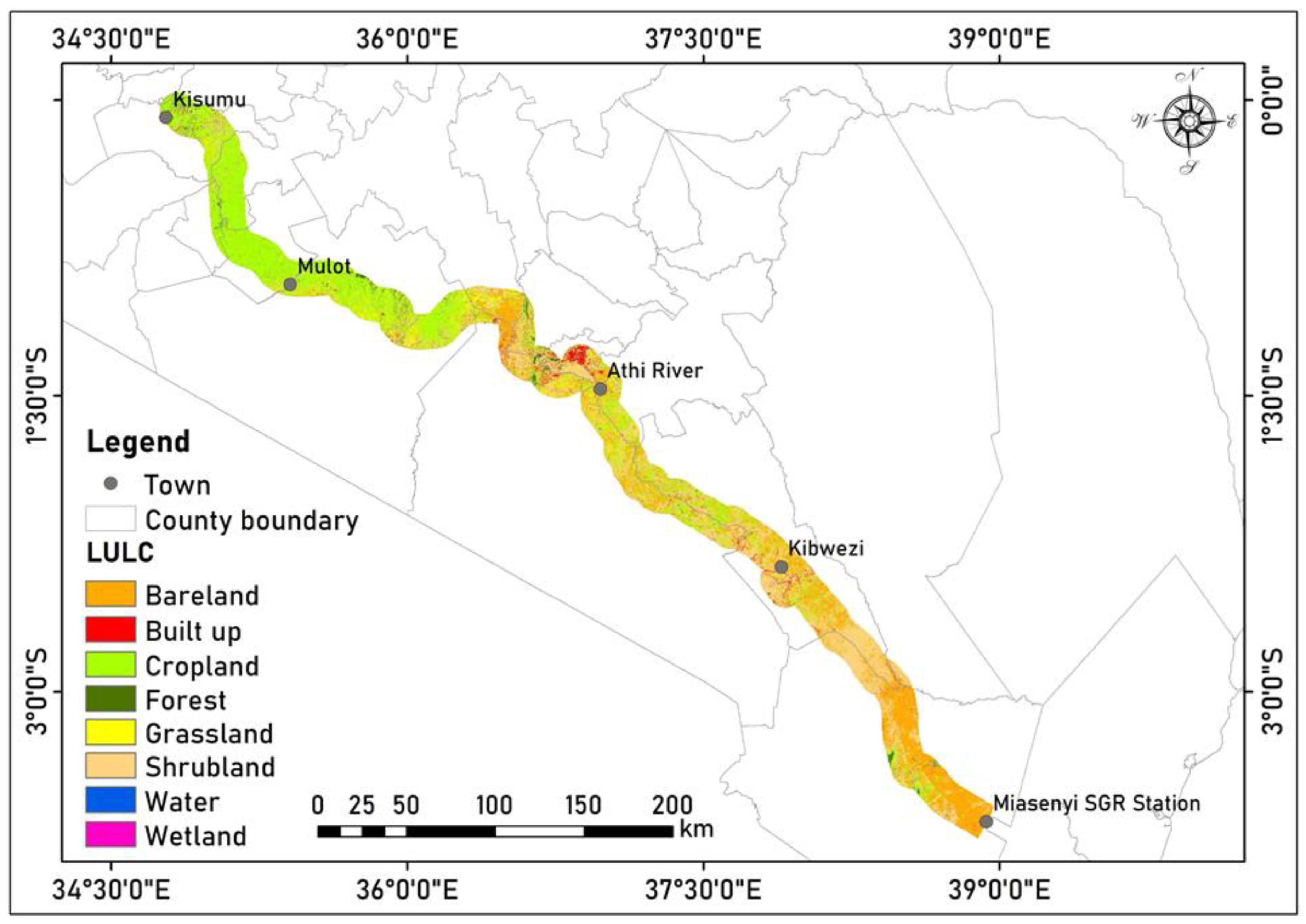
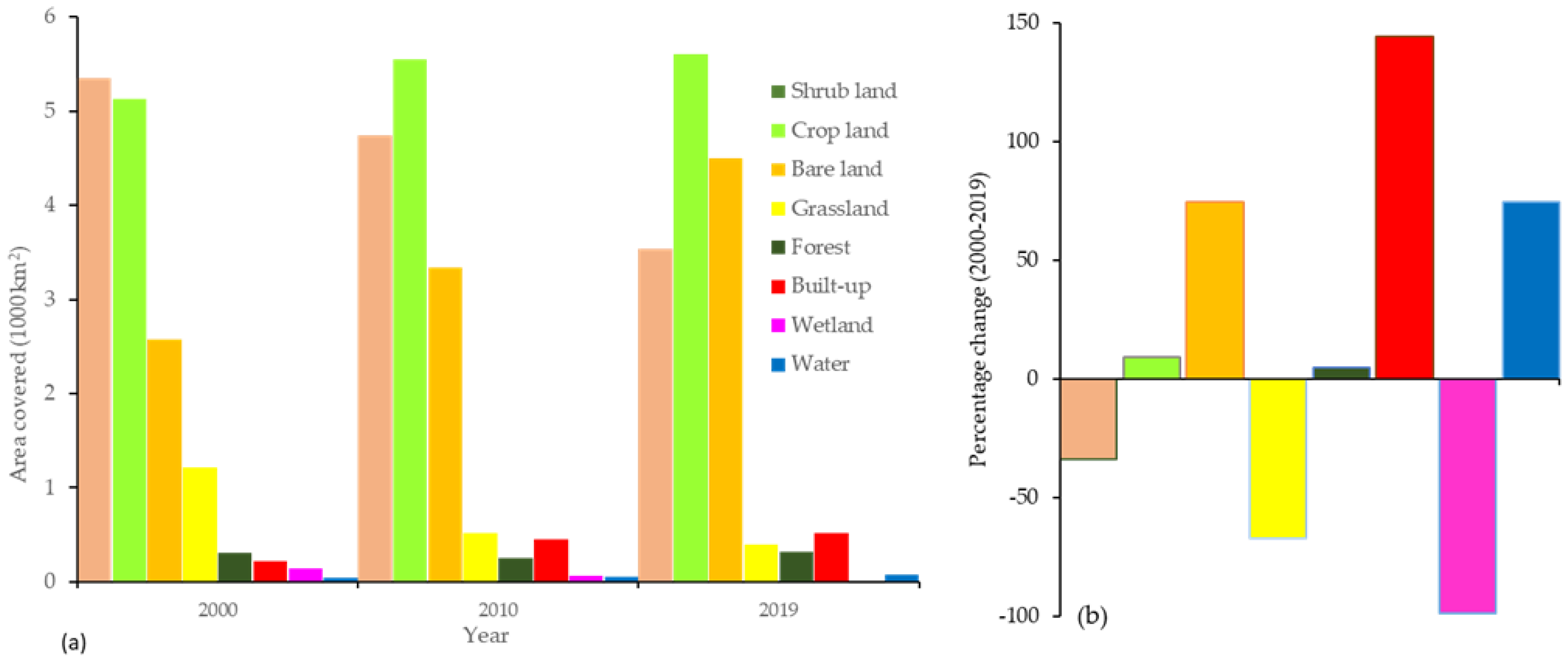
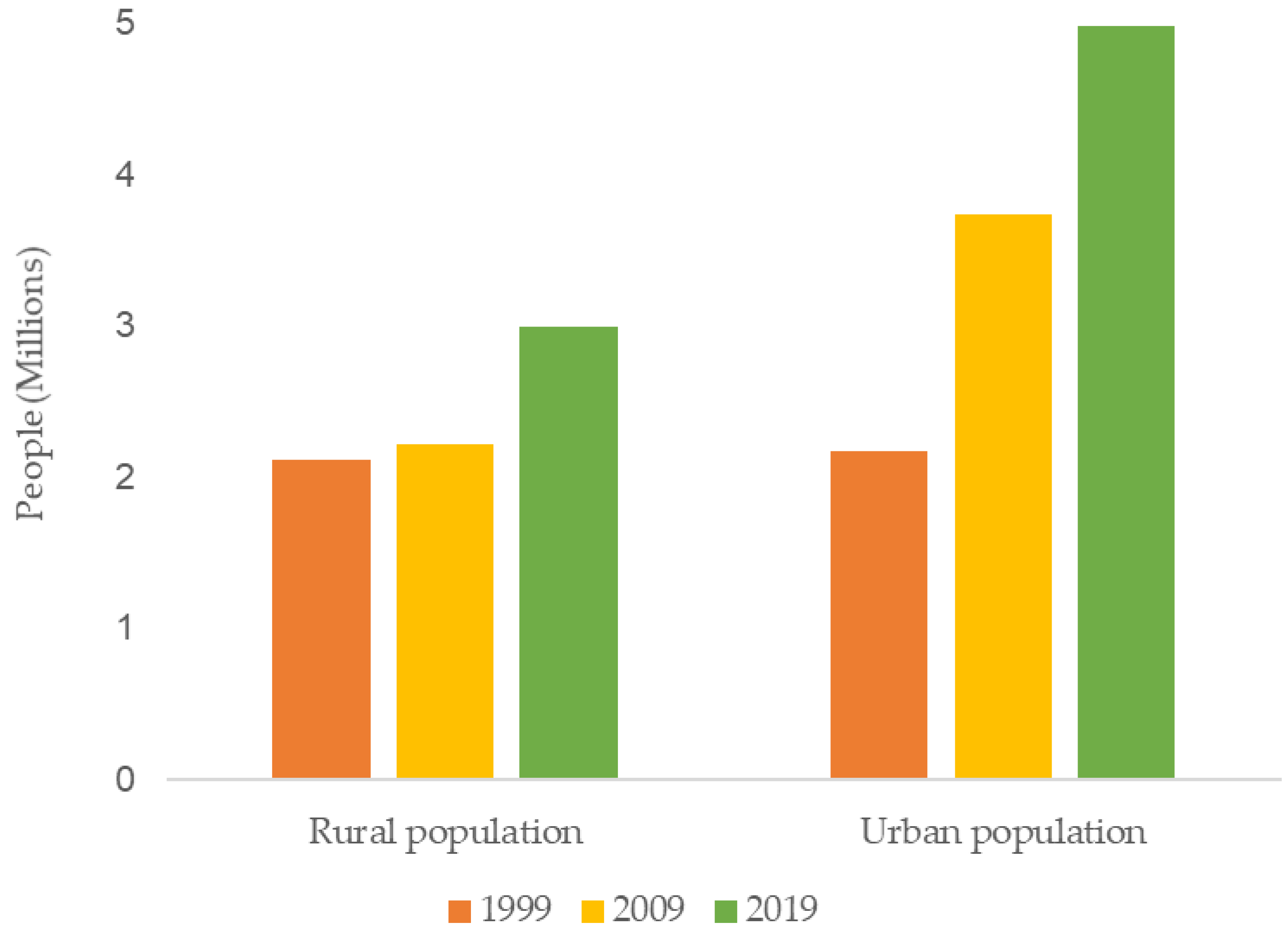
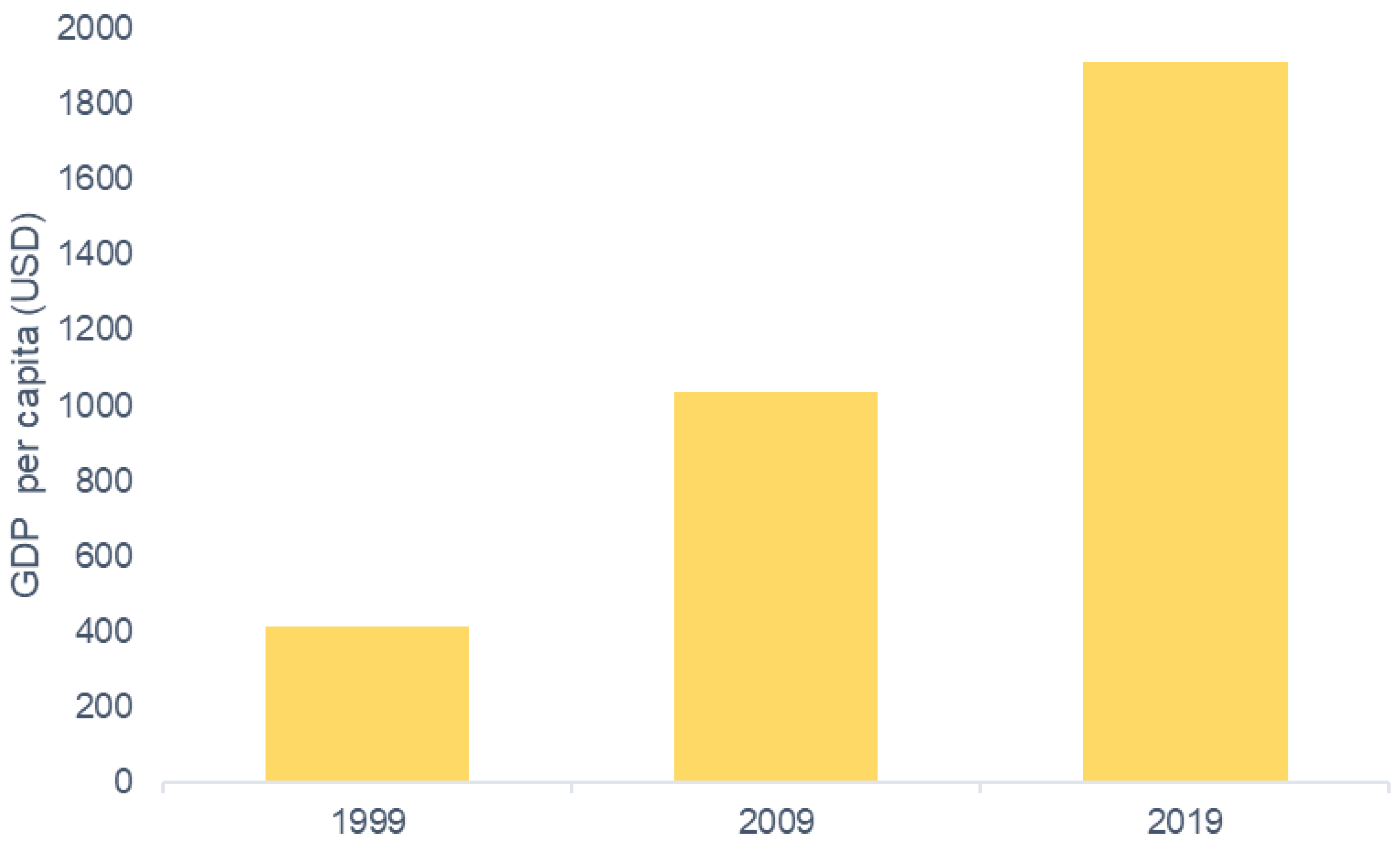
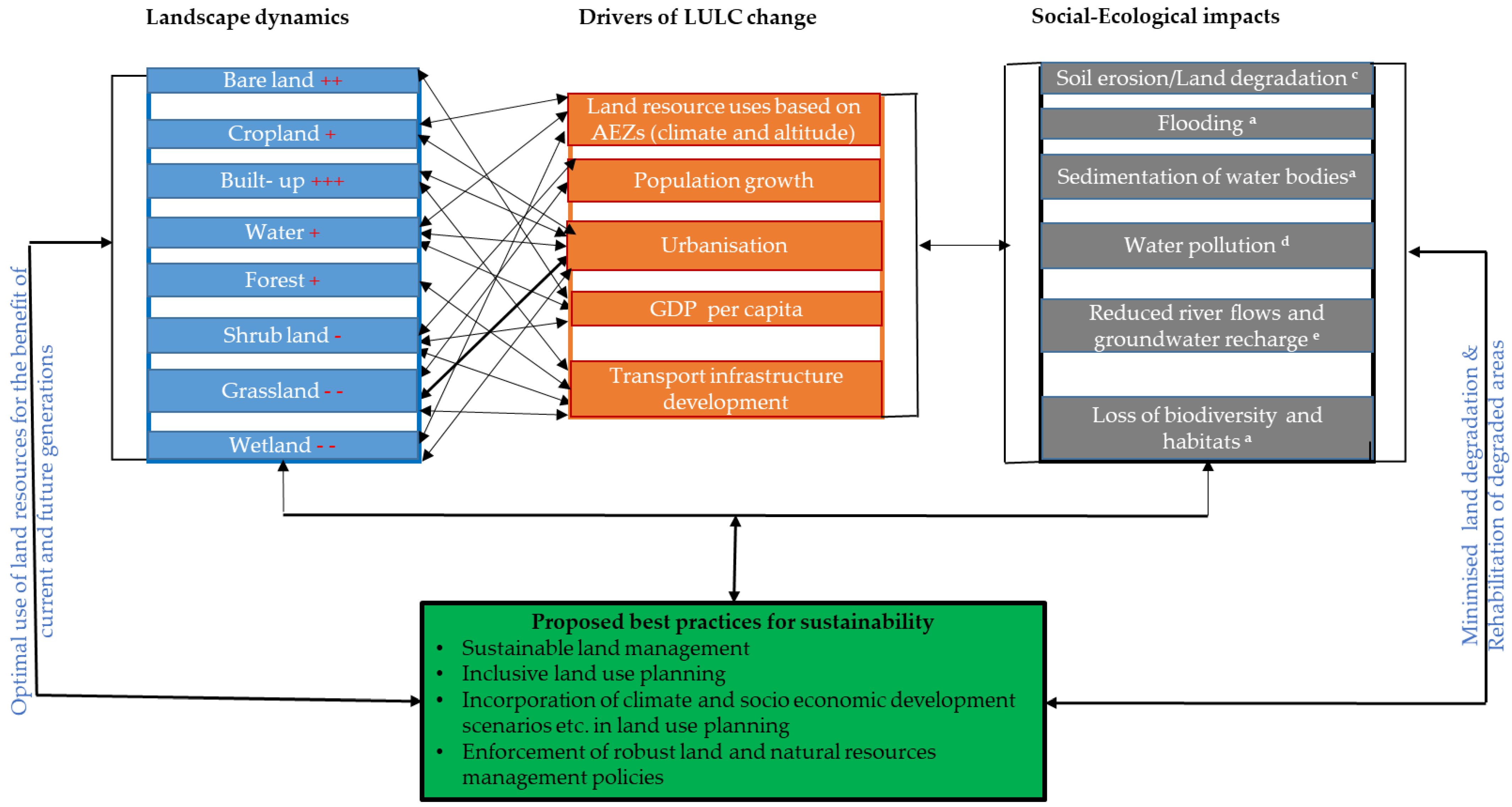
| Mean Annual Temperature | Annual Rainfall | ||||
|---|---|---|---|---|---|
| Subhumid | Semi-Humid | Semi-Arid | Arid | ||
| Lower midland | 21 °C–24 °C | >1000 mm | 900–1800 mm | 300–600 mm | 200–400 mm |
| Upper midland | 18 °C–21 °C | >1000 mm | 900–1800 mm | 300–600 mm | 200–400 mm |
| Lower highland | 15 °C–18 °C | >1000 mm | 900–1800 mm | 300–600 mm | 200–400 mm |
| Land Use Land Cover | Land Use Land Cover Change | |||||||||||
|---|---|---|---|---|---|---|---|---|---|---|---|---|
| LULC | 2000 | 2010 | 2019 | 2000–2010 | 2010–2019 | 2000–2019 | ||||||
| km2 | % | km2 | % | km2 | % | km2 | % | km2 | % | km2 | % | |
| Bare land | 423 | 10.51 | 660 | 16.40 | 861 | 21.40 | 237 | 56.03 | 201 | 30.45 | 438 | 103.55 |
| Built-up | 36 | 0.89 | 81 | 2.01 | 76 | 1.89 | 45 | 125.00 | −5 | −6.17 | 40 | 111.11 |
| Cropland | 1250 | 31.06 | 1247 | 30.99 | 1258 | 31.26 | −3 | −0.24 | 11 | 0.88 | 8 | 0.64 |
| Forest | 151 | 3.75 | 112 | 2.78 | 94 | 2.34 | −39 | −25.83 | −18 | −16.07 | −57 | −37.75 |
| Grassland | 225 | 5.59 | 76 | 1.89 | 99 | 2.46 | −149 | −66.22 | 23 | 30.26 | −126 | −56.00 |
| Shrub land | 1826 | 45.38 | 1803 | 44.81 | 1608. | 39.96 | −23 | −1.26 | −195 | −10.82 | −218 | −11.94 |
| Water | 25 | 0.62 | 24 | 0.60 | 28 | 0.70 | −1 | −4.00 | 4 | 16.67 | 3 | 12.00 |
| Wetland | 88 | 2.19 | 21 | 0.52 | 0. | 0.00 | −67 | −76.14 | −21 | −100.00 | −88 | −100.00 |
| Total | 4024 | 100.00 | 4024 | 100.00 | 4024 | 100.00 | - | - | - | - | - | - |
| Land Use Land Cover | Land Use Land Cover Change | |||||||||||
|---|---|---|---|---|---|---|---|---|---|---|---|---|
| LULC | 2000 | 2010 | 2019 | 2000–2010 | 2010–2019 | 2000–2019 | ||||||
| km2 | % | km2 | % | km2 | % | km2 | % | km2 | % | km2 | % | |
| Bare land | 694 | 19.17 | 876 | 24.19 | 738 | 20.38 | 182 | 26.22 | −138 | −15.75 | 44 | 6.34 |
| Built-up | 122 | 3.37 | 163 | 4.50 | 253 | 6.99 | 41 | 33.61 | 90 | 55.21 | 131 | 107.38 |
| Cropland | 1152 | 31.81 | 1289 | 35.60 | 1222 | 33.75 | 137 | 11.89 | −67 | −5.20 | 70 | 6.08 |
| Forest | 74 | 2.04 | 62 | 1.71 | 106 | 2.93 | −12 | −16.22 | 44 | 70.97 | 32 | 43.24 |
| Grassland | 512 | 14.14 | 266 | 7.35 | 166 | 4.58 | −246 | −48.05 | −100 | −37.59 | −346 | −67.58 |
| Shrub land | 1039 | 28.69 | 919 | 25.38 | 1112 | 30.71 | −120 | −11.55 | 193 | 21.00 | 73 | 7.03 |
| Water | 7 | 0.19 | 20 | 0.55 | 23 | 0.64 | 13 | 185.71 | 3 | 15.00 | 16 | 228.57 |
| Wetland | 21 | 0.58 | 26 | 0.72 | 1 | 0.03 | 5 | 23.81 | −25 | −96.15 | −20 | −95.24 |
| Total | 3621 | 100.00 | 3621 | 100.00 | 3621 | 100.00 | - | - | - | - | - | - |
| Land Use Land Cover | Land Use Land Cover Change | |||||||||||
|---|---|---|---|---|---|---|---|---|---|---|---|---|
| LULC | 2000 | 2010 | 2019 | 2000–2010 | 2010–2019 | 2000–2019 | ||||||
| km2 | % | km2 | % | km2 | % | km2 | % | km2 | % | km2 | % | |
| Bare land | 86 | 4.74 | 148 | 8.16 | 120 | 6.62 | 62 | 72.09 | −28. | −18.92 | 34 | 39.53 |
| Built-up | 16 | 0.88 | 38 | 2.09 | 28 | 1.54 | 22 | 137.50 | −10 | −26.32 | 12. | 75.00 |
| Cropland | 932 | 51.38 | 956 | 52.70 | 1079 | 59.48 | 24 | 2.58 | 123 | 12.87 | 147 | 15.77 |
| Forest | 57 | 3.14 | 62 | 3.42 | 53 | 2.92 | 5 | 8.77 | −9 | −14.52 | −4 | −7.02 |
| Grassland | 265 | 14.61 | 66 | 3.64 | 61 | 3.36 | −199 | −75.09 | −5 | −7.58 | −204 | −76.98 |
| Shrub land | 444 | 24.48 | 529 | 29.16 | 457 | 25.19 | 85 | 19.14 | −72 | −13.61 | 13 | 2.93 |
| Water | 3 | 0.17 | 6 | 0.33 | 15 | 0.83 | 3 | 100.00 | 9 | 150.00 | 12 | 400.00 |
| Wetland | 11 | 0.61 | 9 | 0.50 | 1 | 0.06 | −2 | −18.18 | −8 | −88.89 | −10 | −90.91 |
| Total | 1814 | 100.00 | 1814 | 100.00 | 1814 | 100.00 | - | - | - | - | - | - |
| Rural Population | Urban Population | GDP per Capita | ||||
|---|---|---|---|---|---|---|
| LULC | R-Squared (R2) | Corr. Coeff (r) | R-Squared (R2) | Corr. Coeff (r) | R-Squared (R2) | Corr. Coeff (r) |
| Shrub land | 0.95 * | −0.97 * | 0.94 * | −0.97 * | 0.98 * | −0.99 * |
| Cropland | 0.44 * | 0.67 * | 0.88 * | 0.94 * | 0.99 * | 1.00 * |
| Bare land | 0.91 * | 0.95 * | 0.97 * | 0.98 * | 0.75 * | 0.86 * |
| Grassland | 0.47 * | −0.68 * | 0.90 * | −0.95 * | 0.99 * | −0.99 * |
| Forest | 0.33 | 0.57 | 0.01 | 0.12 | 0.05 | −0.23 |
| Built-up | 0.57 * | 0.75 * | 0.95 * | 0.97 * | 0.77 * | 0.88 * |
| Wetland | 0.79 * | −0.89 * | 1.00 * | −1.00 * | 0.91 * | −0.95 * |
| Water | 0.88 * | 0.94 * | 0.98 * | 0.99 * | 0.31 | −0.56 |
Publisher’s Note: MDPI stays neutral with regard to jurisdictional claims in published maps and institutional affiliations. |
© 2022 by the authors. Licensee MDPI, Basel, Switzerland. This article is an open access article distributed under the terms and conditions of the Creative Commons Attribution (CC BY) license (https://creativecommons.org/licenses/by/4.0/).
Share and Cite
Sang, C.C.; Olago, D.O.; Nyumba, T.O.; Marchant, R.; Thorn, J.P.R. Assessing the Underlying Drivers of Change over Two Decades of Land Use and Land Cover Dynamics along the Standard Gauge Railway Corridor, Kenya. Sustainability 2022, 14, 6158. https://doi.org/10.3390/su14106158
Sang CC, Olago DO, Nyumba TO, Marchant R, Thorn JPR. Assessing the Underlying Drivers of Change over Two Decades of Land Use and Land Cover Dynamics along the Standard Gauge Railway Corridor, Kenya. Sustainability. 2022; 14(10):6158. https://doi.org/10.3390/su14106158
Chicago/Turabian StyleSang, Catherine C., Daniel O. Olago, Tobias O. Nyumba, Robert Marchant, and Jessica P. R. Thorn. 2022. "Assessing the Underlying Drivers of Change over Two Decades of Land Use and Land Cover Dynamics along the Standard Gauge Railway Corridor, Kenya" Sustainability 14, no. 10: 6158. https://doi.org/10.3390/su14106158
APA StyleSang, C. C., Olago, D. O., Nyumba, T. O., Marchant, R., & Thorn, J. P. R. (2022). Assessing the Underlying Drivers of Change over Two Decades of Land Use and Land Cover Dynamics along the Standard Gauge Railway Corridor, Kenya. Sustainability, 14(10), 6158. https://doi.org/10.3390/su14106158







